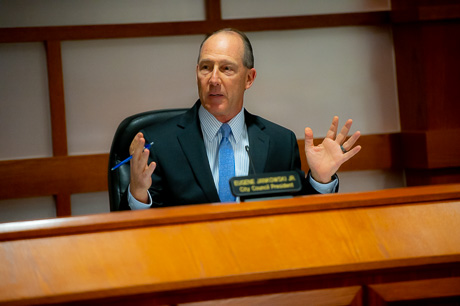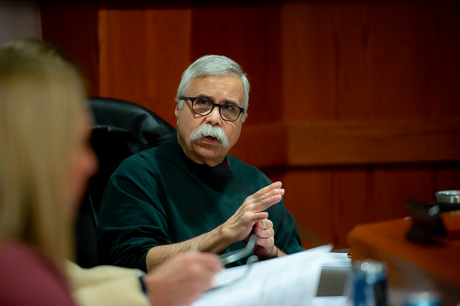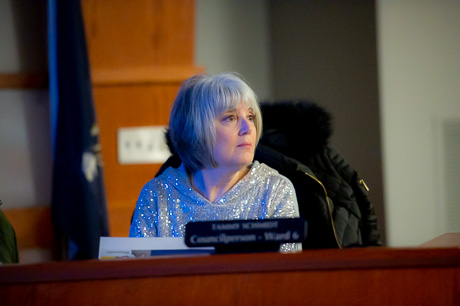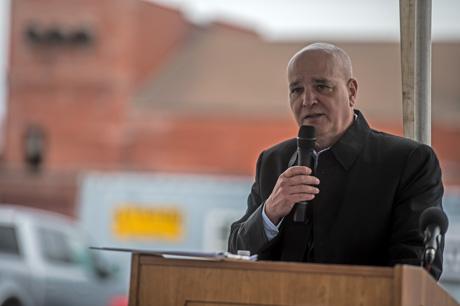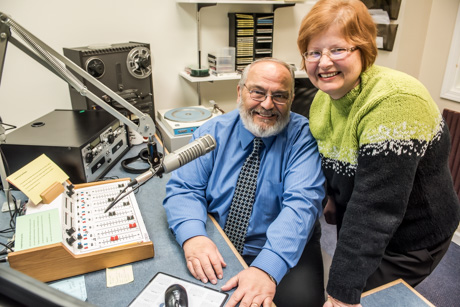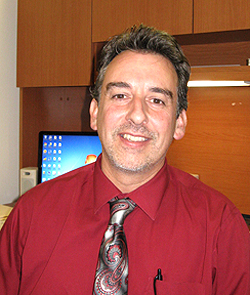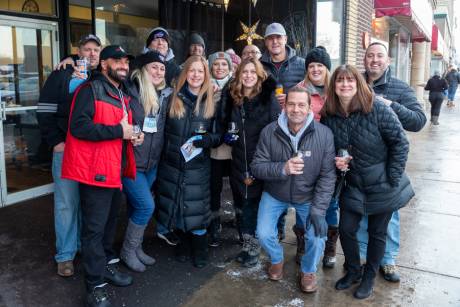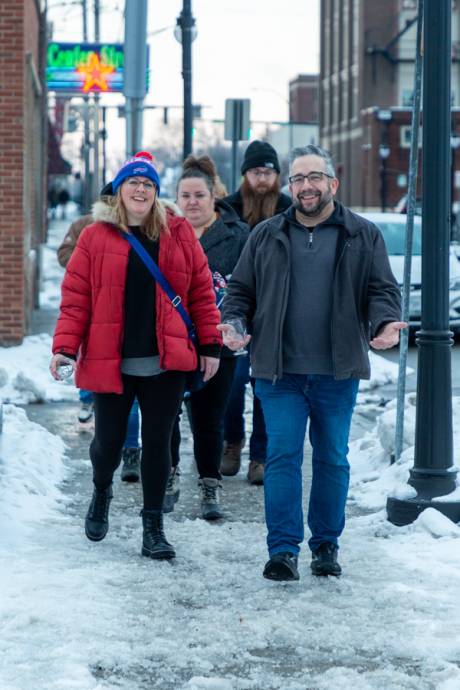While city officials have expressed surprise and disappointment about the details of Ellicott Station, developer Samuel Savarino and Steve Hyde, CEO of the county’s Economic Development Center, remain enthusiastic about the possibilities to come along with the 55-unit, low-income apartment complex in Batavia.
During an interview with The Batavian, Savarino was steadfast about tenants being employed and able to pay their rents at the 50 Ellicott St. site.
“Our project is one- and two-bedroom, which I think could be said fits the profile of young workers or working couples,” he said.
The Batavian asked about the maximum income qualifications, per the Ellicott Station application, which in some cases means people making minimum wage wouldn’t qualify for a two-person apartment. Savarino said that those numbers were fixed in 2019, per 50 to 60 percent of the area median income at the time. And they’re not set in stone.
“When things change every year, the income restrictions are reset, just as there are changes in the area median income and what people earn. So, you know, that changes over time. But, I think it really does set at some are 50 and the majority are 60 percent of AMI, right? And that's back in 2019 numbers,” he said. “And the project has to be up and operating before it gets reset. So if wages have gone up in that time, then the income restrictions will go up, and if they’re going down, the income restrictions will go down.”
He isn’t sure why city officials are upset about the low-income qualifications and Section 8 availability, he said, since the project has been geared toward what’s affordable for the Batavia area per a market study from the project's inception. It is true, he said, that Home and Community Renewal’s involvement — which happened when the state entity granted him more than $5 million in tax credits to get the project going — also meant a market study review and conclusion about what would be considered affordable.
“I think we had a market study which looked at … I mean, everybody can maybe look around things and draw their own conclusions. And, you know, a market study is a little more detailed … it's a little more refined, and more scientific with determining what the achievable rents would be and whether there would be people to rent at certain levels. Any market study will do that,” he said. “And if you looked at the application that went in to the unified funding application to Home and Community Renewal, which provides the tax credits, which an investor purchases, and then they provide some financing for the projects, that it was workforce housing, affordable workforce housing.
“And that's consistent with what everybody was saying. It can be reset, but that's what we need to follow … at the suggestion of HCR after they examined the market study. My recollection was that they said, that's where the market was. And that was where the need was.
“I’m not quite sure if there's an Oxford dictionary definition of what is affordable as opposed to workforce, as opposed to low income. You know, it depends. And it may mean different things in different communities,” he said.
Those terms are used interchangeably, he said. Above all, he envisions working singles and couples, or perhaps seniors on a fixed income, living at Ellicott Station. Given the low-income levels, what’s the chance that many would also require government assistance to make the rent if they qualified for those income levels? Savarino wasn’t familiar with how Section 8 works, he said, but it does work the same as with any other rental. It's illegal to discriminate against a tenant with Section 8 requirements, he said.
His management will be screening applicants to ensure they have a job and can pay rent, he said. Furthermore, he believes they will be “good tenants” living in a good, quality residence with plenty of security cameras, and secured access to the building. The Batavian asked him why the playground was built and promoted if he didn’t think the apartments had the space for children — which he had said during the interview — and it is a mandated requirement, he said.
As for the meanings of workforce, affordable and low income, The Batavian had previously published an article citing the definitions, per the Housing and Urban Development site. Though, in talking to various people regarding this project, those words did seem a bit murkier. Savarino disputed a statement in a prior Batavian article that he had quoted specific, ideal wages of $18 to $20, and also $20 and below. He didn’t recall having said that, though it was captured on a recorder. None of the maximum incomes allow for those wages or even $14 in some cases.
The calculations worked out to take 30 percent of one’s salary for rent and utilities, he said, and leave the remaining 70 percent for other expenses. That means tenants could potentially have disposable income to dine at downtown restaurants or do some shopping, which was one of the original goals of the project, he said.
The other goals were to include commercial and retail projects at the site, and, due to the lengthy time it took to get going, Resurgence Brewing “timed out” and completed a project in its own neighborhood, Savarino said. He has some interested prospects and is committed to following through with a brewery/restaurant with either an outside company or Savarino Companies itself.
Steve Hyde, president and CEO of Genesee County's Economic Development Center, focused on another aspect of the project — the longstanding and dilapidated defunct buildings at 30-50 Ellicott St. Ellicott Station was designed initially “and continues to contribute to helping achieve the goals of the Batavia Brownfield Opportunity Area (BOA) and the Downtown Revitalization Initiative (DRI),” he said.
He pulled an excerpt from the DRI application for the Build Ellicott Station Project:
“The DRI program will be a comprehensive approach to boost Batavia’s economy by transforming the downtown into a vibrant neighborhood where the next generation will want to live, work and raise a family. A key component of the DRI program is to advance strategic private and public investments that will provide catalytic impacts to facilitate downtown revitalization.”
“I believe the Ellicott Station Project, in its current form, continues on this path by making public/private investments, revitalizing a blighted parcel which is helping to transform our downtown into a vibrant neighborhood that offers opportunities for our young adults in the community to live, work, play and raise a family in a significantly upgraded area of downtown Batavia,” Hyde said. “We continue to work closely with Developer Sam Savarino and his team to deliver upon his commitment to construct new, modern, and affordable workforce housing for working residents who have modest incomes across our community. This is a critical element to downtown revitalization efforts because not only does Ellicott Station renovate a blighted parcel in our downtown but it is building workforce housing units for working residents in the heart of our downtown many of whom would have the opportunity to work at our area businesses which are sorely needed.”
Hyde and Savarino also pointed to the benefit of having nearby housing for employees that businesses are seeking. Without local residents, it has been difficult at times for employers to fill vacancies, Savarino said. It also equips downtown with tenants within walking distance, Hyde said.
“This further strengthens the opportunity for greater success for our Main Street businesses and our local economy. I confirmed with Developer Sam Savarino last week that his commitment to deliver workforce housing for working residents is priority #1. The incentives provided by GCEDC to support the comprehensive re-development of this mixed use project did comprehend the 60 percent or less AMI and associated range of incomes contemplated for the workforce housing facility as reflected in our public hearing minutes, the board memoranda and final resolution from our March 2020 Board meeting,” he said. “The net of this is: The GCEDC Board of Directors trusted in Sam Savarino to deliver workforce housing for working residents in an effort to incentivize considerable investment and improvements to transform the biggest eyesore in our downtown into a new mixed-use development. They continue steadfast in their expectation of Mr. Savarino to honor his commitment to provide high-quality workforce housing for working residents across our community.
He and Savarino look forward to the project’s completion, and neither seems to believe that the income qualifications are too low to bring prosperity to the city of Batavia, per questions asked by The Batavian and the focused answers.
“I personally continue to look forward to the positive benefits provided by the Ellicott Station project which includes offering new apartments to our working residents priced in an affordable fashion that would allow them to live, work and play downtown,” Hyde said. “This will, in my view, help to elevate the staffing availability and success of our area businesses – our Main Street businesses in particular. That is the promise we continue to expect and the main premise why GCEDC has participated actively in this project over the course of the last eight years.”
Photo: File photo of Sam Savarino at the Ellicott Station groundbreaking by Howard Owens




































